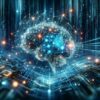We bet it’s hard to find a person who hasn’t heard about it yet. Machine learning (ML) is gaining momentum today. According to Statista, growing at a whopping 17.15% annual growth rate, the ML market size is predicted to cross the $500 billion mark by 2030. But what does it stand for?

Let’s start with a machine learning definition. Basically, it’s a subset of artificial intelligence (AI) that enables machines to learn on their own. The learning takes place thanks to large volumes of data. ML algorithms are trained to interpret and analyze data to detect relationships and patterns in it. Using these findings, ML systems can generalize unseen data, classify information, make predictions, generate content, and do much more.
Simply put, ML enables computers to learn and refine their performance over time, as well as perform new tasks without explicit instructions. Now, let’s delve deeper into this matter to get machine learning explained in a clear and easy-to-understand manner.
Why is machine learning such a big thing now?
Although the concept of machine learning was introduced back in 1959, this technology is only starting to gain momentum now. As the concept evolves and strengthens, it finds a multitude of use cases across a variety of industries and mediums. Hence, its influence and importance keep growing.
First and foremost, ML is trending thanks to its ability to access, structure, and analyze huge volumes of data. Thanks to this, the technology is capable of performing a variety of tasks that are beyond humans’ abilities (at least, on the same large scale). Some of the most well-known use cases include:
- Speech recognition;
- Translations;
- Virtual assistance;
- Pattern recognition;
- Product recommendation;
- Fraud detection;
- And so on.
All in all, machine learning enables us to extract valuable insights from all kinds of data sets. For example, in the educational sector, it’s already used for learning analytics. ML assesses large volumes of information about students’ performances, struggles, and other indicators and then assists with grading, predicting future performances, and creating personalized learning experiences.
Similarly, ML is used in all other fields – from finance to healthcare. And it has an enormous potential. Not without reason, large corporations like Google, Facebook, Uber, and others are already placing ML at the heart of their operations.
How does this technology work?
So, what is machine learning? In order to answer this question, you must understand the three core processes taking place in ML models:
- A decision process – Most commonly, ML models are used for data classification or prediction purposes. So, the first process that takes place is a decision process – the algorithm analyzes input data (whether labeled or unlabeled) and detects patterns in it.
- An error function – This process is meant to assess the prediction made by the algorithm. If there are any earlier examples of a similar task, the model can use them to compare predictions and evaluate the accuracy.
- A model optimization process – If there is a way for the algorithm to fit the data points in the training set better, it will adjust weights (the learned traits) to reduce the discrepancy between the given sample and the current version of the model. The system will repeat this process autonomously until it reaches the desired threshold of accuracy.
Key learning methods used in ML
Supervised learning
Supervised machine learning, or simply supervised learning, is the first learning method used in ML. It implies using labeled data to train algorithms for classification or prediction tasks. Here’s how it works – to get started, users need to input labeled training datasets into the model. The model will then analyze these sets and adjust their weights accordingly until they fit the given data points. This learning method enables users to find solutions to numerous real-world problems and scale them.
Common methods used in this learning method include:
- Neural networks;
- Logistic regression;
- Linear regression;
- Support vector machine (SVM), etc.
Unsupervised learning
Unsupervised machine learning, or just unsupervised learning, is the method of using ML algorithms for clustering and analyzing unlabeled sets of data. According to the machine learning definition, unsupervised models that use this training method are capable of detecting hidden patterns or data groups without human intervention. Thanks to its ability to bring out similarities and differences in large datasets, this model is perfect for pattern recognition, data analytics, customer segmentation, and similar purposes.
The primary algorithms used in unsupervised learning include:
- Principal component analysis (PCA);
- Neural networks;
- Singular value decomposition (SVD);
- Probabilistic clustering methods;
- And so on.
Semi-supervised learning
As you can guess from its name, semi-supervised machine learning is a concept that brings together both supervised and unsupervised methodologies. While being trained, such models use small labeled datasets for the purpose of guiding information classification and feature extraction from broader, unlabeled datasets. Semi-supervised machine learning technology is a perfect solution for cases when the scope of labeled data isn’t sufficient enough for implementing a supervised learning algorithm. Also, it can come in handy when a sufficient amount of unlabeled data turns out to be too costly.
The future potential of machine learning
As you already know, machine learning technology is growing at a rapid pace, finding more and more applications across various industries. One part of its fast growth is dictated by a huge amount of research on this matter made by governments, companies, and universities all across the world. Thanks to massive investments and research, we currently observe daily improvements and breakthroughs in the fields of ML and AI. And the world doesn’t seem to be stopping there. Even now, when these technologies are still in their infancy, we can confidently state that they are going to play a massive role in the future, helping us make our work and daily lives better.
In the natural language processing sector, we expect to see even more fluent conversational AI powered by advanced ML models. As this technology evolves, NLP algorithms will be able to handle more tasks and serve even more purposes than they can now.
Thanks to the ability to analyze large datasets and detect trends and patterns in them, ML is also projected to simplify a huge number of manual tasks for humans. Whether in business or education, ML will soon let us gain even more insights and make more informed decisions in everything we do. And it’s going to offer even more precision and efficiency for sure.
All in all, the future of ML is bright. Millions of dollars invested into it by leading companies only confirm this statement. Still, despite all the benefits, of course, there will be certain challenges in adopting this technology that we need to overcome to make the most out of it.



